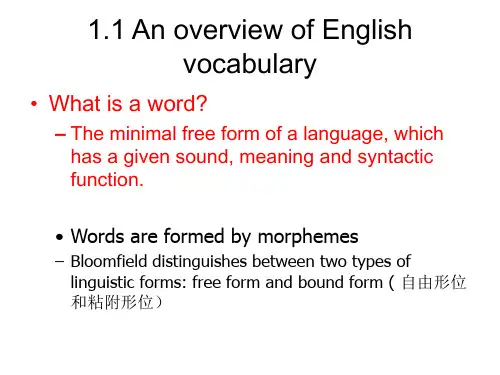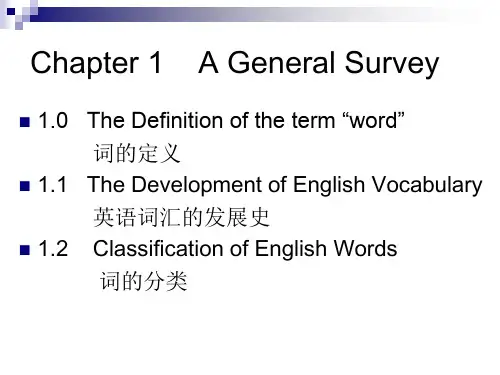现代英语词汇学概论第一课课件
- 格式:ppt
- 大小:183.00 KB
- 文档页数:26
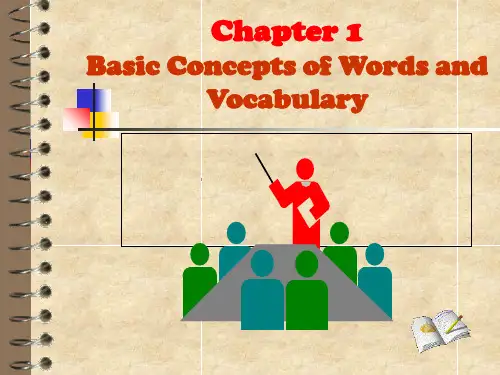

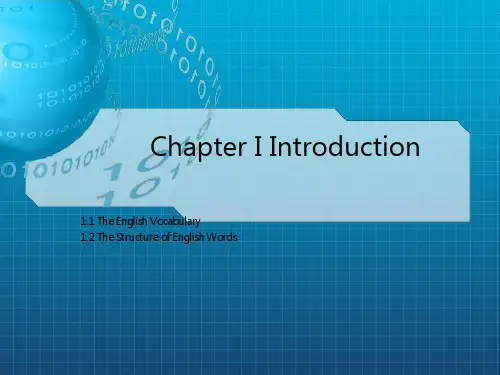
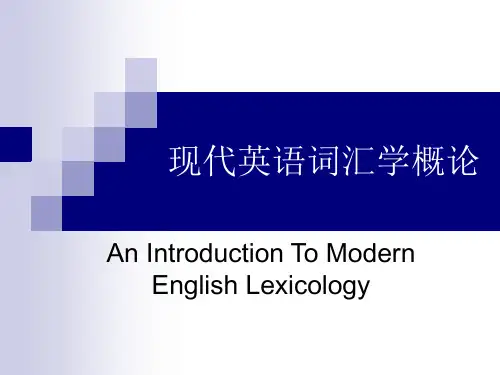
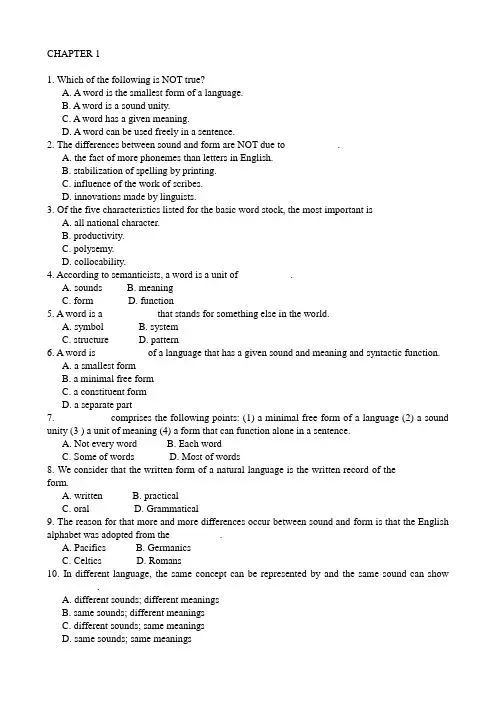
CHAPTER 11. Which of the following is NOT true?A. A word is the smallest form of a language.B. A word is a sound unity.C. A word has a given meaning.D. A word can be used freely in a sentence.2. The differences between sound and form are NOT due to __________.A. the fact of more phonemes than letters in English.B. stabilization of spelling by printing.C. influence of the work of scribes.D. innovations made by linguists.3. Of the five characteristics listed for the basic word stock, the most important isA. all national character.B. productivity.C. polysemy.D. collocability.4. According to semanticists, a word is a unit of __________.A. soundsB. meaningC. formD. function5. A word is a __________ that stands for something else in the world.A. symbolB. systemC. structureD. pattern6. A word is__________ of a language that has a given sound and meaning and syntactic function.A. a smallest formB. a minimal free formC. a constituent formD. a separate part7. __________ comprises the following points: (1) a minimal free form of a language (2) a sound unity (3 ) a unit of meaning (4) a form that can function alone in a sentence.A. Not every wordB. Each wordC. Some of wordsD. Most of words8. We consider that the written form of a natural language is the written record of the __________ form.A. writtenB. practicalC. oralD. Grammatical9. The reason for that more and more differences occur between sound and form is that the English alphabet was adopted from the__________.A. PacificsB. GermanicsC. CelticsD. Romans10. In different language, the same concept can be represented by and the same sound can show __________.A. different sounds; different meaningsB. same sounds; different meaningsC. different sounds; same meaningsD. same sounds; same meanings11. The internal reason for the difference between sound and form is __________.A. stabilization of quelling by printingB. the fact of more phonemes than letters in EnglishC. influence of the work of scribesD. innovations made by linguists12. In old English sound and form are __________.A. differentB. not the sameC. consistent greatlyD. inconsistent greatly13. Which is not the reason for the disagreement between sound and form?A. The early scribes created some differences between sound and form.B. The pronunciation has changed more rapidly than spelling.C. The importance of government.D. The borrowing.14. In spite of the differences, at least __________ percent of the English words fit consistent spelling patterns.A. sixtyB. seventyC. eightyD. ninety15. The general estimate of the present-day English vocabulary is over __________ words.A. one billionB. two millionC. two billionD. one million16. If we classify English words by use frequency, the two types of words are __________.A. the basic word stock and nonbasic vocabularyB. content words and functional wordsC. native words and borrowed wordsD. functional and notional words17. Words can be classified according to the following criteria EXCEPT __________.A. notionB. use frequency.C. foundationD. origin18. Words may fall into content words and functional words by __________,A. use frequencyB. notionC. originD. stability19. Usually words of the basic word stock are supposed to have obvious _________characteristics.A. threeB. fourC. fiveD. six20. Which of the following is not a characteristic of the basic word stock?A. Polysemy.B. Colloquialism.C. Productivity.D. Stability.21. __________prefers to the specialized vocabularies by which members of particular arts, sciences, trades and professions communicate among themselves.A. SlangB. ArgotC. JargonD. Archaism22. Nonbasic vocabulary includes __________.A. argot and jargonB. archaisms and neologismsC. technical termsD. all the above23. Which category do the following words fall into: photo-scanning, trigonometry, sonata and audiovisual?A. Neologism.B. Jargon.C. Terminology.D. Slang.24. __________belong to the sub-standard language, a category that seems to stand between the standard general words including informal ones available to everyone and in-group words.A. JargonsB. SlangsC. ArgotsD. Dialectal words25. __________are words or forms that were once in common use but are now restricted only to specialized or limited use.A. NeologismsB. ArchaismsC. native words and borrowed wordsD. functional words and notional words26. Newly-created words or expressions, or words that have taken on new meanings are __________.A. dialectal wordsB. jargonsC. argotsD. neologisms27. The expression "can-opener" , which means all-purpose key, belongs to __________.A. slangsB. terminologiesC. argotsD. archaisms28. Which of the following word is the neologism?A. cantB. persuaderC. chookD. E-mail29. __________are words used only by speakers of the dialect in question.A. ArgotsB. SlangsC. JargonsD. Dialectal words30. Archaisms are words or forms that were once in __________use but are now restricted only to specialized or limited use.A. commonB. littleC. slightD. great31.| __________ constitute the main body of the English vocabulary.A. Functional wordsB. Content wordsC. NumeralsD. Pronouns32. Which types of words belong to functional words?A. Adverbs, prepositions, conjunctions.B. Adjectives, nouns, articles.C. Articles, prepositions, conjunctions.D. Verbs, pronouns, prepositions.33. Which of the following is not content word?A. fiveB. andC. earthD. never34. Content words denote clear notions and thus are known as __________ words. They include nouns, verbs, adjectives, adverbs and numerals.A. functionalB. notionalC. emptyD. formal35. Functional words do not have notions of their own. Therefore, they are also called __________ words. Prepositions, conjunctions, auxiliaries and articles belong to this category.A. contentB. notionalC. emptyD. new36. Native words have __________ features.A. twoB. sevenC. fiveD. six37. Which are the features of native words?A. All national characters.B. Neutral in style.C. Frequent in use.D. All the above.38. The words borrowed from French or Latin are mostly __________.A. colloquialB. informalC. formalD. slangy39. The characteristic of native words is __________.A. neutral in style C. formal in styleB. informal in style D. slangy in style40. Native words are characterized with __________.A. high slang feature in styleB. high argot feature in useC. high markedness in styleD. high frequency in use41. __________ is estimated that English borrowings constitute percent of the modern English vocabulary.A. 60B. 70C. 80D. 9042. Which of the following isn't the denizen?A. PortB. CupC. DécorD. Shirt43. Which of the following isn't the alien?A. DecorB. BazaarC. ShiftD. Emir44. Which of the following doesn't belong to the translation-loans?A. Mother tongue.B. Long time no see.C. Black humour.D. Status quo.45. Which of the following statements is CORRECT?A. The English language is noted for its modest borrowings.B. Loan words only refer to those borrowings in form.C. Loan words are all unrecognizable as being foreign in origin.D. Loan words can be grouped according to manner of borrowing.46. The words “kow-tow” in English is called an alien word because _________.A. it is a newly-created word from another language.B. it has been assimilated into the English languageC. it has undergone a semantic changeD. it has retained its original pronunciation47. Which of the following belongs to the semantic-loans?A. ChangeB. PorkC. DreamD. Tea48. _________ is the most important of all characteristics of the basicA. ProductivityB. StabilityC. CollocabilityD. All national character49. Nonbasic vocabulary includes all of the following except _________.A. slangB. Anglo-Saxon wordsC. argotsD. neologisms50. According to the origins of the words, English words can be classified into _________.A. content words and functional wordsB. native words and borrowed wordsC. basic words and dialectal wordsD. loan words and dialectal words51. Borrowings can be divided into _________.A. aliens, semantic loans, translation loans, denizensB. empty words, notional words, form words, content wordsC. blends, portmanteau words, acronyms, initialismsD. derivatives, compounds, converted words and clipped words52. Apart from the characteristics of basic vocabulary, native words have two other features, namely _________.A. productivity and stabilityB. neutrality in style and high frequency in useC. collocability and polysemyD. formality and arbitrariness53. The word beaver (meaning "girl") is _________.A. a dialectal wordB. argotC an archaism D. slang54. AIDS as a nonbasic word is _________.A. jargonB. an archaismC. a neologismD. slang55. Form words include the following word classes except _________.A. conjunctionsB. auxiliariesC. prepositionsD. adjectives56. V ocabulary can refer to the following except _________.A. the total number of the words in a languageB. all the words used in a particular historical periodC. all the words of a given dialectD. most words a person knows57. Kimono is a loan word from _________.A. GermanB. FrenchC. SpanishD. Japanese58. _________ form the mainstream of the basic word stock.A. Anglo-Saxon wordsB. French wordsC. Danish wordsD. Latin words59. Black humour is _________.A. a translation loanB. a semantic loanC. a denizenD. an alien60. Pronouns and numerals are semantically _________ and have limitedA. polysemous; use and stabilityB. monosemous; collocability and stabilityC. polysemous; use and productivityD. monosemous; productivity and collocability61. Indigestion is _________.A. jargonB. slangC. terminologyD. an archaism62. By _________, words fall into functional words and content words.A. use frequencyB. notionC. originD. word formation63. The symbolic connection between sound and meaning is almost always _________.A. motivatedB. arbitraryC. logicalD. unconventional64. _________ are loan words that have become assimilated in English.A. DenizensB. Semantic loansC. Translation loansD. Aliens65. Smoky, which means "police", is a(n) _________ word.A. slangB. argotC. loanD. jargon66. Wherein which means "in what" is a(n) _________ word.A. slangB. archaicC. functionalD. dialectal67. The difference between sound and form due to all the following except _________.A. more phonemes than lettersB. stabilization of spelling by printingC. change of spelling by early scribesD. development of pronunciation68. A word is _________ of a language that has a given sound and meaning and syntactic function.A. a smallest formB. a minimal free formC. a constituent formD. a separate part69. In different languages, the same concept can be represented by _________ and the same sound can show _________.A. different sounds/different meaningsB. the same sounds/different meaningsC. different sounds/the same meaningsD. the same sounds/the same meanings70. The internal reason for the difference between sound and form is _________.A. stabilization of spelling by printingB. the fact of more phonemes than letters in EnglishC. influence of the work of scribesD. innovations made by linguists71. In old English sound and form are _________.A. differentB. not the sameC. consistent greatlyD. inconsistent greatly72. Which is not the reason for the disagreement between sound and form?A. the early scribes created some differences between sound and formsB. the pronunciation has changed more rapidly than spellingC. the importance of governmentD. the borrowing73. The relationship between the sound and meaning of a word is _________.A. logicalB. arbitrary, conventionalC. predictableD. objective74. In spite of the disagreement between sound and form, _________ of the English words fit consistent spelling patterns.A. only thirty percentB. at least seventy percentC. at least eighty percentD. sixty percent75. The words of the basic word stock constitute _________ of the English vocabulary.A. a small percentageB. a large percentageC. fifty percentD. ninety percent76. _________ is the most important of all features of basic words.A. StabilityB. ProductivityC. PolysemyD. All national character77. Words may fall into the basic word stock and non-basic vocabulary by _________.A. use frequencyB. notionC. originD. meaning78. Which of the following is not a characteristic of the basic word stock?A. polysemyB. ColloquialismC. productivityD. stability79. Non-basic vocabulary includes _________.A. argot and jargonB. archaisms and neologismsC. technical termsD. all the above80. _________ are words or forms that were once in common use but are now restricted only to specialized or limited use.A. Neologisms B- ArchaismsC. JargonD. Terminology81. Newly-created words or expressions, or words that have taken on new meanings are _________.A. dialectal wordsB. jargonC. argotD. neologisms82. The expression "can-opener" , which means all-purpose key, belongs to _________.A. slangB. terminologyC. argotD. archaisms83. Which category do the following words fall into: photoscanning, trigonometry, sonata and audiovisual?A. NeologismsB. JargonC. TerminologyD. Slang84. Which of the following is neologisms?A. cockyB. E-mailC. aughtD. symphony85. By _________, words can be grouped into content words and functional words.A usage B. originC. notionD. Feature86. Which types of words belong to functional words?A. adverbs, prepositions, conjunctionsB. adjectives, nouns, articlesC. articles, prepositions, conjunctionsD. verbs, pronouns, prepositions87. Which of the following is not content word?A. fiveB. andC. earthD. never88. Functional words are also called _________ words.A. basicB. borrowedC. emptyD. Compound89. Which of the following words is a functional word?A. alwaysB. neverC. thoughD. table90. As far as the origins of the words are concerned, English words can be classified into _________and _________.A. native words, borrowed wordsB. basic words, non-basic wordsC. content words, functional wordsD. formal words, informal words91. Native words have _________ features.A. twoB. sevenC. fiveD. six92. Native words are words brought to Britain in the fifth century by _________ tribes.A. CeltsB. GermanC. NorwegianD. French93. Which are the features of native words?A. all national characterB. neutral in styleC. frequent in useD. all the above94. The words borrowed from French or Latin are mostly _________.A. colloquialB. informalC. formalD. slang95. Loan words can be divided into four classes: _________.A. Translation-loans, Denizens, Jargon and Semantic-loansB. Denizens, Translation-loans, Aliens and Semantic-loansC. Denizens, Collocation, Aliens and Translation-loansD. Denizens, Aliens, Jargon and Translation-loans96. _________ are words borrowed early in the past and now well-assimilated into English language.A. DenizensB. AliensC. Translation-loansD. Semantic-loans97. If we classify English words by use frequency, the two types of words are __________.A. the basic word stock and nonbasic vocabularyB. content words and functional wordsC. native words and borrowed wordsD. functional words and notional words98. Lexicology is a branch of linguistics, inquiring into __________ of words.A. the lexical and grammar meaningsB. the origins and meaningsC. only the originsD. only the meanings99. According to the textbook, the general estimate of the present- day English vocabulary is over __________.A.10,000,000B. 20,000,000C.1,000,000D. 2,000,000100. Words can be classified according to the following criteria EXCEPT __________.A. notionB. use frequencyC. foundationD. origin101. Words of the basic word stock are characterized withA. polysemy, productivity, collocability, hyponymy and antonymyB. collocability, all national character, productivity, stability, and hyponymyC. productivity, polysemy, stability, collocability and antonymD. all national character, stability, polysemy, productivity and collocabilitv102. The criteria of words include __________.A. all national characterB. a cluster of lettersC. sound unityD. multisyllable103. The characteristics of native words include __________.A. neutral in styleB. formal in styleC. informal in styleD. slangy in style104. __________ is traditionally used for the study of the origins and history of the form and meaning of words.A. SemanticsB. MorphologyC. EtymologyD. Stylistics105. Content words denote clear notions and thus are known as __________ words. They include nouns, verbs, adjectives, adverbs and numerals.A. functionalB. notionalC. emptyD. formal106. The words borrowed from French or Latin are mostly __________.A. colloquialB. informalC. slangyD. formal107. Semantics is the study of meanings of different __________ levels: lexis, syntax, utterance, discourse, etc.A. linguisticB. grammaticalC. arbitraryD. semantic108. Neologisms are newly-created words or expressions, or words that have taken on __________ meanings.A. newB. oldC. badD. good109. Functional words do not have notions of their own. Therefore, they are also called __________ word, Preposition, conjunctions, auxiliaries and articles belong to this category.A. contentB. notionalC. emptyD. new110. Which of the following characteristics of the basic; word stock the most important of all features that may differentiate words of common use from all others?A. Stability.B. Collocability.C. Productivity.D. All national character.111. The word "kowtow" in English is called an alien word because __________.A. it is a newly-created word from another languageB. it has been assimilated into the English languageC. it has undergone a semantic changeD. it has retained its original pronunciation and spelling112. Which of the following words is a functional word?A. Five.B. Never.C. But.D. Desk1. A word is a _________ free form of a language that has a given sound and meaning and syntactic function.2. There is no _________ relationship between the sound which stands for a thing or an idea and the actual thing and idea itself.3. The relationship between a word and the thing it stands for is _________.4. Prepositions, conjunctions, _________ and articles all belong to functional words.Mm5. All the words in a language make up its _________.6. According to the degree of _________ and _________ of borrowings, we can bring the loan-words under four classes.7. The basic word stock is the _________ of the vocabulary accumulated over centuries.8. Translation-loans are words and expressions formed from _________ in the English language but modelled on the patterns taken from another language.9. _________ are borrowed words which have retained their original pronunciation and spelling.10. There are four types of borrowed words: _________, aliens, translation-loans and semantic-loans.11. The expression of "Long time no see" is _________ among the four classes of borrowings.12. Slang is often used in _________ situations.13. Argot generally refers to the jargon of _________.14. Content words are changing all the time whereas _________ words are stable.15. By _________, words can be classified into native words and borrowed words.16. Native element refers to the words of _________ origin.17. The proportion of the use of native words is much _________ than that of borrowings.18. Borrowed words which still sound foreign and look foreign are_______________.19. There is no ________________ relationship between sound and _________ as the connection between them is ____________ and conventional.20. _____________ are borrowings that have become naturalized or assimilated in English.21. Archaisms are words no longer in ____________ use or ___________ in use.22. Content words are changing all the time whereas functional words are __________. ____________ words enjoy a ______________ frequency in use than content words.23. A word whose meaning was borrowed from another language is called __________.24. Lexicology is a branch of linguistics, studying the origins and __________ of __________ words.25. A word is a minimal free form of a language that has a given sound, meaning and __________function.26. In spite of the differences between sound and form, at least __________ percent of the English words fit consistent spelling patterns.27. All the words in a language make up its __________.28. The __________ word stock is the foundation of the vocabulary accumulated over centuries and forms the common core of the language.29. By __________, begin is a native word.30. __________ vocabulary include cant, jargon and argot.31. There is no __________ relationship between the sound which stands for a thing or an idea and the actual thing and idea itself.32. __________ are basic units of sentences.33. Early borrowings are mostly __________ whereas later loan words remain foreign sound and spelling.33. The __________ approach in lexicology study is concerned with the vocabulary of a language as it exists at a given time.34. Content words are changing all the time whereas __________ words are stable.35. There are generally two approaches to the study of words, namely synchronic and __________.36. The relationship between the sound and the meaning of a word is __________.37. Pronouns and numerals enjoy nation-wide use and stability, but have limited productivity and __________.38. Language study involves the study of speech sounds, grammar and __________.39. A word is a __________ free form that has a given sound, given and __________ functions.40. The relationship between __________ and __________ is arbitrary and conventional41. The basic word stock is the __________ of the vocabulary accumulated over centuries.42. Words can be grouped into content words and functional words by __________.43. Content words include nouns, verbs, adjectives, adverbs and __________.44. Functional words, which make up a very __________ number of the vocabulary, remain stable.45. Prepositions, conjunctions, __________ and articles all belong to functional words.46. Native element refers to the words of __________ origin.47. Native words are in style and __________ in use.48. The proportion of the use of native words is much than that of borrowings.49. According to the degree of __________ and __________ of borrowing, we can bring the loan¬words under four classes.50. Translation-loans are words and expressions formed from __________ in the English language but modelled on the patterns taken from another language.51. __________are borrowed words which have retained their original pronunciation and spelling.52. There are four types of borrowed words: __________, aliens, translation-loans and semantic- loans.53. The expression of "Long time no see" is __________among the four classes of borrowings. ( ) 1. A word can be defined in different ways from different points of view.( ) 2. Under no circumstances can sound and meaning be intrinsically related.( ) 3. The introduction of printing press resulted in a lot more differences between sound and form.( ) 4. The words a person can use in speaking and writing form his active vocabulary.( ) 5. The principles by which to classify words are usage, notion and origin.( ) 6. Native words are more popular than foreign words.( ) 7. Native words enjoy the same features as the basic word stock and more.( ) 8. Auld (meaning "old") is an instance of archaism.( ) 9. Kowtow is a loan word known as an alien.( ) 10. Long time no see is a case of translation loan.( ) 11 A word is the minimal meaningful unit of a language.( ) 12. The connection between sound and meaning is conventional and arbitrary( ) 13. Under no circumstances can sound and meaning be logically related( ) 14. In different Languages the same concept can be represented by different sounds.( ) 15. The introduction of printing press resulted in a lot more differences between sound and form.( ) 16. The sound and form are consistent all the time.( ) 17. The work erf scribes is the internal reason for the differences between sound and( ) 18. All the words in a language make up its vocabulary.( ) 19. The words a person can use in speaking and writing form his active vocabulary.( ) 20. The general estimate of the present-day English vocabulary is over one million words. ( ) 21. The principles by which to classify words are usage, notion and origin.( ) 22. The characteristics of the basic word stock include all national character, denizen and productivity.( ) 23. The basic words can form new words with other roots and affixes, which refers to the productivity.( ) 24. Words belonging to the basic word stock often possess more than one meaning.( ) 25. Dialectal words are words used only by speakers of the dialect in question.( ) 26. Content words are numerous and more frequendy used than functional words on average. ( ) 27. Native words are more popular than foreign words.( ) 28. Native words enjoy the same features as the basic word stock and more.( ) 29. The expression of "mother tongue" from "lingua materna" is semantic-loan.Give a term for each of the following definitions.1. Sub-standard words often used on informal occasions. ( )2. Specialized vocabulary common in certain professions. ( )3. Words used by sub-cultural groups, particularly by underground society. ( )4. Words that have clear notions. ( )5. Words of Anglo-Saxon origin. ( )6. Words borrowed by way of translation. ( )7. Old words with new meanings. ( )8. Words which have become assimilated. ( )9. Native forms whose meanings are borrowed. ( )10. Words essential to native speakers' daily communication. ( )1. Illustrate the relationship between sound and meaning with examples.2. What do you think of the following definitions of "word"?a) "... a sound or group of sounds that symbolizes a meaning and is viewed as not being capable of division into smaller independent units. "b) "Any sound or combination of sounds (or its written or printed symbol, customarily shown with a space on either side of it but none within it) forming meaningful element of speech, conveying an idea or alternative ideas, and capable of serving as a member of, the whole of, or a substitute for, a sentence." (COD)3. What are the criteria for classification of words? What are the fundamental features of the basic word stock of the English vocabulary? Why do we say that native words are the core of the English?4. What are the characteristics of the English vocabulary as a result of its historical development?5. Why are there so many differences between sound and form?。
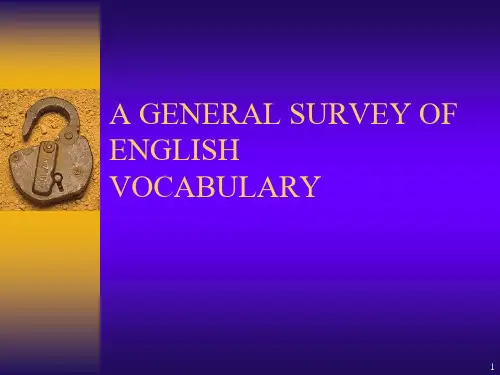
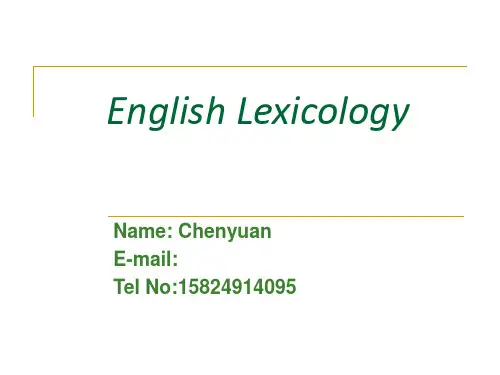
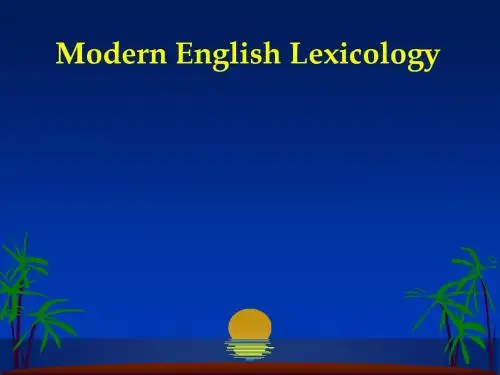
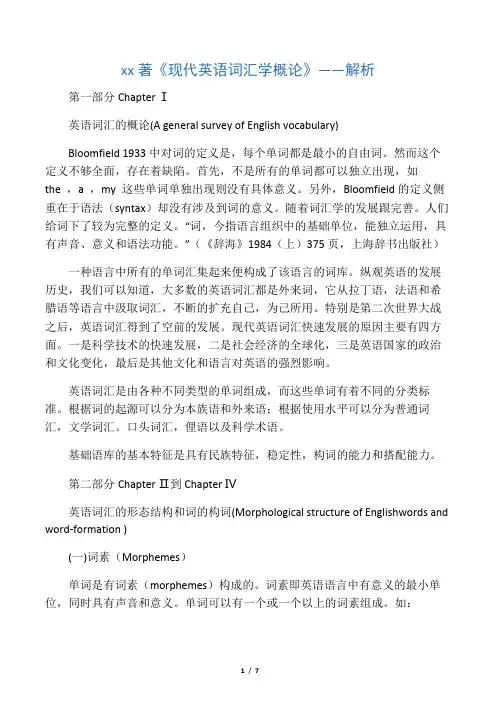
xx著《现代英语词汇学概论》——解析第一部分Chapter Ⅰ英语词汇的概论(A general survey of English vocabulary)Bloomfield 1933中对词的定义是,每个单词都是最小的自由词。
然而这个定义不够全面,存在着缺陷。
首先,不是所有的单词都可以独立出现,如the ,a ,my 这些单词单独出现则没有具体意义。
另外,Bloomfield的定义侧重在于语法(syntax)却没有涉及到词的意义。
随着词汇学的发展跟完善。
人们给词下了较为完整的定义。
“词,今指语言组织中的基础单位,能独立运用,具有声音、意义和语法功能。
”(《辞海》1984(上)375页,上海辞书出版社)一种语言中所有的单词汇集起来便构成了该语言的词库。
纵观英语的发展历史,我们可以知道,大多数的英语词汇都是外来词,它从拉丁语,法语和希腊语等语言中汲取词汇,不断的扩充自己,为己所用。
特别是第二次世界大战之后,英语词汇得到了空前的发展。
现代英语词汇快速发展的原因主要有四方面。
一是科学技术的快速发展,二是社会经济的全球化,三是英语国家的政治和文化变化,最后是其他文化和语言对英语的强烈影响。
英语词汇是由各种不同类型的单词组成,而这些单词有着不同的分类标准。
根据词的起源可以分为本族语和外来语;根据使用水平可以分为普通词汇,文学词汇。
口头词汇,俚语以及科学术语。
基础语库的基本特征是具有民族特征,稳定性,构词的能力和搭配能力。
第二部分Chapter Ⅱ到Chapter Ⅳ英语词汇的形态结构和词的构词(Morphological structure of Englishwords and word-formation )(一)词素(Morphemes)单词是有词素(morphemes)构成的。
词素即英语语言中有意义的最小单位,同时具有声音和意义。
单词可以有一个或一个以上的词素组成。
如:nation 是一个词素,national有nation+al 两个词素。
